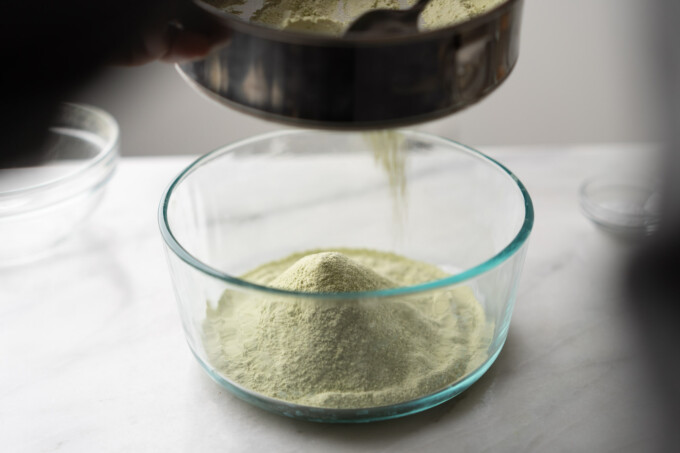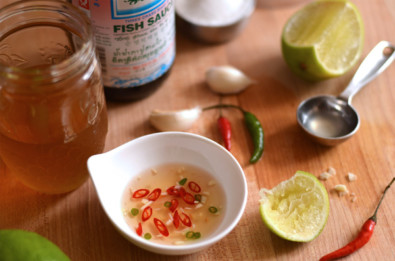These matcha cookies taste rich and earthy, with added complexity from the browned butter, sweetness from the white chocolate chips, and nuttiness from the black sesame seeds. Learn how to get the chewiest matcha cookies with my tried and true methods below.

Why matcha in cookies?
Matcha is a type of green tea that has gained a lot of popularity throughout the years, and you can find matcha everywhere on Instagram and the Internet. It’s made from crushed green tea leaves to make a vibrant green tea powder. These days you can find matcha-flavored anything like lattes, mochi, ice cream, and cookies. If you ask me, I love a good chewy cookie that isn’t too sweet, and I think this cookie is a great example.
Ingredients in matcha cookies

Many of the ingredients in these matcha cookies are similar to sugar cookies but with a bit more complexity due to the browned butter. I used unsalted browned butter, bread flour, all-purpose flour, culinary-grade matcha powder, baking powder, kosher salt, light brown sugar, white cane sugar, egg, and vanilla extract.
For our add-ins, I chose sweet white chocolate chips to balance out the slightly bitter flavor of the matcha and roasted black sesame to enhance the natural nuttiness of the tea. I also tried using multiple types of white chocolate chips and found that Ghiradelli white chocolate chips melted the best.
Tips for making matcha cookies

Here are some of my tried and true methods to get extra chewy matcha cookies:
- Use the right type of ingredients to change the texture. Certain ingredients create a chewier texture, like melted (brown) butter, a mixture of bread and all-purpose flour, and brown sugar. If you prefer a softer and airier texture, use softened butter, only use all-purpose flour, and a higher percentage of white cane sugar to brown sugar.
- Use a combination of bread flour and all-purpose flour. Mixing two types of flour creates the perfect chewy consistency without making it overly crispy or too airy.
- Sift all the dry ingredients (except kosher salt). Sifting removes any lumps and helps incorporate the matcha into the flour and other dry ingredients. When I didn’t sift, I ended up with unmixed matcha clumps in the cookie dough.
- Don’t overmix the wet ingredients. We do not, I repeat, we do NOT want light and airy cookies for this recipe so you don’t need to cream the sugars and butter together. In fact, I try to mix the wet ingredients minimally to prevent overmixing and adding air into the batter.
- Chill the cookie dough before baking. Chilling dough allows the flavors to marinate more, preventing the cookies from spreading too much or creating crispy cookies.
- Don’t overbake. Matcha turns brown if baked too high or too long, so I keep it at 10 minutes max in an oven at 350 °F. We’ll take out the cookies when the centers are high and still a little wet.
- Let it cool and rest. Allowing the cookies to rest and cool helps improve their chewy texture. They finish off baking from the residual heat. Letting it rest for 15 minutes on a cooling rack will give you chewy cookies. If you move them too soon, they’ll break apart and be too soft.

Is matcha good for baking?
Culinary matcha is made for baking because it is often bolder in flavor than other varieties, like ceremonial matcha. Make sure to use culinary matcha from a reputable brand; otherwise, you may end up with less potent matcha that doesn’t taste very good after baking.
What kind of matcha powder is used in baking?

I used culinary-grade matcha meant for baking and cooking for this recipe because it has a bolder (and sometimes bitter) flavor. Culinary grade (sometimes called “cooking” or “grade A” matcha) is lower in quality than ceremonial matcha, which has a more nuanced and lighter flavor. Ceremonial matcha is traditionally used in ceremonies but is also widely used today by matcha lovers who prefer to drink matcha on its own, as opposed to using it in baked goods or lattes.
Culinary matcha is also much more inexpensive than ceremonial matcha. From my experience, culinary matcha also comes in larger bags, so you have more product to use for an affordable price.
Why do my matcha cookies turn brown?

Baking for too long will cause the green color of your matcha cookies to turn brown and change color. We’ll bake these cookies for only 10 minutes, even if they seem a bit wet in the middle, because they eventually settle and become chewy after cooling.
What pairs well with matcha?
Matcha pairs well with so many sweet and savory flavors, and it’s so fun to mix and match ingredients, especially for these cookies. Some flavors and ingredients you may want to add in are shredded coconut, black sesame paste, white miso, macadamia nuts, and strawberries.

Matcha Cookies with White Chocolate Chips
Ingredients
- 112 g (1 c) unsalted butter
- 97.5 g (¾ c) bread flour
- 32.5 g (¼ c) all-purpose flour
- 6.6 g (1 tbsp) matcha powder culinary grade
- 1.4 g (¼ tsp) baking soda
- 1.4 g (½ tsp) kosher salt
- 90 g (½ c) light brown sugar
- 25 g (2 tbsp) white cane sugar
- 1 large egg room temperature
- 4 g (1 tsp) vanilla extract
- 140 g (¾ c) white chocolate chips
- roasted black sesame seeds for topping
Equipment Used
- light-colored saute pan
- spatula
- measuring cups and spoons or weighted scale
- sifter
- heat-safe bowls
- #24 disher optional
- parchment paper
- cookies sheets or baking sheet pans
Instructions
- In a light-colored saute pan over medium heat, melt the unsalted butter and continue to cook for about three to five minutes or until it turns golden brown and the fat solids turn a dark brown and settle to the bottom. Stir continuously to prevent burning. It should NOT be black or smell acrid–this would mean it’s burnt.
- Transfer the brown butter to a heat-safe bowl and set aside to chill.
- Combine the bread flour, all-purpose flour, matcha powder, and baking soda in a bowl and mix until incorporated.
- Sift the dry ingredients into a bowl.
- Add the kosher salt to the sifted dry ingredients and mix.
- In a separate bowl, add the cooled browned butter, brown sugar, white cane sugar, egg, and vanilla extract. Mix together until incorporated, but do not overmix. Overmixing can create cookies with soft and cake-like textures.
- Add the sifted dry ingredients into the wet bowl and mix together.
- Add the white chocolate chips.
- Gently mix to combine chocolate chips.
- Line a sheet pan with parchment paper.
- Use a #24 disher to scoop out individual cookie mounds and place them onto the parchment paper. If you are using a tablespoon, it’s about 2 ¾ tablespoons per cookie.
- Chill the cookie dough in the fridge for at least two hours. (If you want to store cookies to make in the future, you need to pre-freeze them for about 30 minutes and then transfer them into an airtight container. They will store for up to 2 months.)
- Preheat the oven to 350 °F.
- Place the cookies into the oven and bake for 10 minutes.
- Remove the cookies and let sit on the sheet pan for two minutes before moving onto a cooling rack. Allow the cookies to cool for another 15 minutes before serving.

















